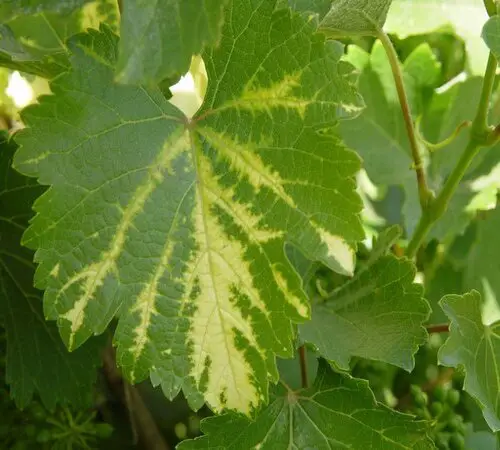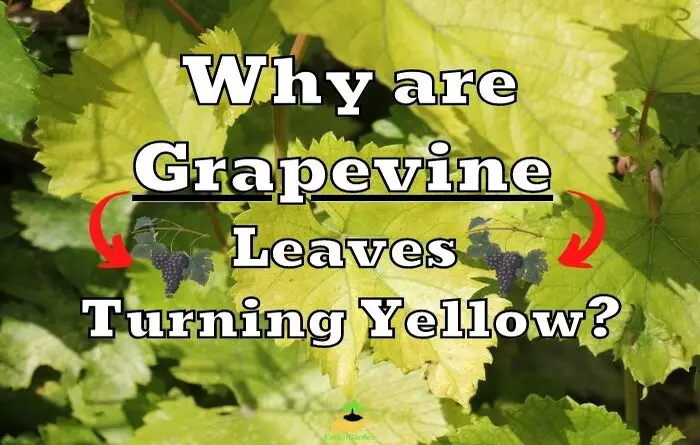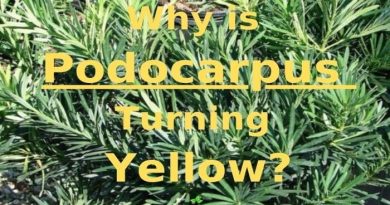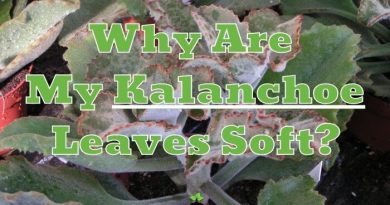6 Reasons Grapevine Leaves Are Turning Yellow (How To Fix It)
Grapevines are not the easiest plant to grow and gardeners sometimes “panic” if, for unknown reasons, grapevine leaves start turning yellow.
The leaves on the grapevine turn yellow for a number of different reasons including lack or excess of water, nutrient deficiency, unsuitable soil, diseases such as chlorosis, or pests. This is a signal to the winegrower that it is time to take some measures to save the vining plant and prevent this issue from happening throughout the vineyard.
1. Incorrect watering
The most common cause of yellowing and drying of the grapevine leaves is irregular watering. First of all, the lower leaves of the grapevine are turning yellow, and then the entire vine.
Water is an essential element that grapevine need for normal growth and development. The main part of the root system penetrates deep into the soil (up to 80-100 cm), which allows the grapevine to live without water for a long time.
However, the grapevine receives nutrition from the upper layer with the help of roots located close to the surface. It is able to absorb all the essential plant elements in dissolved form, so water is an important component of grapevine care.
At the same time, water provides the delivery of useful nutrients to cells and participates in the process of photosynthesis. Also contributes to the cooling of the vine, especially during the hot period (summer).
If you do not properly water the grapevine, especially in dry weather, the leaves start turning yellow, starting from the middle.
The root system during this period is experiencing great stress. Therefore, after a certain period of time, it begins to weaken and dry out.
And in any case, do not overfill. Because excess water (waterlogging) leads to stagnation of moisture and rotting of the roots which helps the development of fungal diseases.
In this case, excess water should be removed by building a drain channel. Before that, loosen the ground.
Treatment
The fact is that the grapes are quite moisture-loving, and you need to water it at least twice a month, soaking the soil to a depth of 40 cm. You will need about 2-3 buckets of water per plant.
To maintain a healthy appearance of the grapevine and the juiciness of the foliage, it is important to regularly irrigate the soil at least twice a month.
In hot weather, this procedure should be carried out more often, at least once a week. Moisture stagnation can be prevented by loosening, and its intensive evaporation from the soil surface by mulching.
Therefore, if you notice such symptoms during dry weather, immediately irrigate the soil.
2. Nutrient deficiency
Often grapevine leaves turn yellow from a lack of nutrient fertilizers with useful elements. Most often, yellowness appears due to a lack of the following essential nutrients:
- Nitrogen
- Potassium
- Iron
- Zinc
- Manganese
- Magnesium
| Nutrient deficiency | Grapevine Symptoms | Treatment |
|---|---|---|
| 1. Nitrogen | Light green yellowish leaves, petioles turn red and slow growth. The leaves become first pale green, then they can turn yellow. | Ammonium nitrate (15-20 grams per 10 liters of water) Urea (35 grams per 10 liters of water). |
| 2. Potassium | The foliage may become either brown or yellow. Yellow edges of the leaves indicate that the plant lacks potassium. | Potassium sulfate (10 g per 10 liters of water) Wood ash (100-200 grams of ash per 10 liters of water ) Potassium sulfate (0.1 – 0.2 g/sq.m) |
| 3. Iron | Whitish lightening and yellowing of the young leaves and shoot tips, leaf edge necrosis. | 1-3% solution of iron sulfate (100-300 grams of per 10 liters of water). Iron chelate (1 and 3 g/ sq. m) |
| 4. Zinc | Yellow-whitish, mosaic-like spots between the leaf veins. Leaves remain small, the development of avaricious shoots is stimulated, stunted growth. | Zinc sulfate (200-400 grams per 10 liters of water) Zinc sulfate or Zinc chelate (0.2 – 0.4 g/sq.m) |
| 5. Manganese | Small yellow spots form on the grapevines. Moreover, the veins and edges of the foliage will have the usual green color. | Manganese sulfate (5 to 15 g per/sq.m) |
| 6. Magnesium | In old leaves, the leaf green disappears between the leaf veins. Yellowish brightening forms in white grapevine varieties. | Epsom salt/magnesium sulfate (0.25 – 0.5 g/sq.m) |
Nitrogen
Yellowness may appear due to the fact that there is not enough nitrogen in the soil. This causes the grapevine green leaves to first become lighter, and then begin turning yellow completely.
Nitrogen is an important component of any protein (the tissues of a living organism are built from it).
Nitrogen deficiency happens not only with a lack of humus, but also with a lack of bacteria responsible for processing organic substances into a form accessible to plants, the growth of grapes slows down, the leaves turn yellow, and then dry up and fall off.
To compensate for the deficiency of nitrogen, you should water the plant with a solution of mullein or chicken droppings, or replace them with ammonium nitrate or urea.
Potassium
With a lack of potassium, the leaves turn yellow only at the edges. Every day the range of yellowing increases. If there is enough potassium and nitrogen in the soil, the grapes will develop well.
It grows quickly, the grapes ripen a little ahead of time, becomes tasty and sweet. And also the plant survives the winter well without complications.
During flowering and fruit formation, it is necessary to spray the bushes with potassium sulfate or a composition of tincture of iodine, baking soda, diluted in water.
To solve the problem, it is recommended to use complex fertilizers that already contain all the necessary components.
Iron
In the process of photosynthesis, which is how plants turn light energy into chemical energy, iron plays a critical part. Lack of iron causes a grapevine to produce less chlorophyll, which causes chlorosis, or the yellowing of the leaves.
Chlorophyll, the green pigment that enables plants to absorb light energy, and other pigments that give leaves their color require iron.
This condition is often called “iron deficiency chlorosis.” Young grapevine leaves or the emerging tips of shoots typically exhibit the earliest signs of yellowing, while the veins of the leaves continue to be green.
Along with this, the vine can be fed with a foliar fertilizer to restore the disturbed metabolism and restore the ability to photosynthesize.
Treatment should be carried out immediately, as soon as the first yellowed or faded leaves appear, so that the disease does not become irreversible.
Zinc
The synthesis of chlorophyll, which gives leaves their green color, depends on the crucial micronutrient zinc, which is involved in many different plant growth and development processes.
Chlorosis, or the yellowing of the leaves, can also result from a zinc shortage in grapevines. This is so that the photosynthesis-related enzymes can work properly. Zinc is required for the production of pigments like chlorophyll and other colors.
Additionally, zinc is necessary for the healthy growth of roots, leaves, and stems as well as for the generation of hormones that control growth. Stunted growth, smaller leaves, and lower grape yields can all be the results of zinc deficiency.
3. Unsuitable soil
Soil composition that is not suitable for grapes is also a factor that causes chlorosis with yellowing of leaves. Planting grapes in unsuitable soil can lead to yellowing of the foliage.
If the soil is alkaline, with a pH above 7-8, the grapevine will most likely start turning yellow.
The fact is that there is a lot of lime in the composition of such soil, which interferes with the absorption of iron by the plant, and without this substance, chlorophylls, which give the leaves a green color, are not formed in the plant.
Here are a few ways unsuitable soil can affect how quickly grapevine leaves are turning yellow:
pH
The availability of some nutrients to plants, especially iron, can be impacted by soil pH. Alkaline soils or soils with a high pH make iron less accessible to grapevines, which can result in iron deficiency chlorosis, or yellowing of the leaves.
Deficiencies in nutrients
Over time, the soil may become depleted of vital nutrients, which can affect plants. As I indicated before, among other elements, a lack of nitrogen, magnesium, iron, potassium, and zinc can result in the yellowing of leaves.
You can include fertilizers designed to replace the deficient nutrient to remedy nutritional shortages. For instance, you can apply a fertilizer high in nitrogen if your soil is poor in nitrogen. You may use chelated iron fertilizer to increase the iron content of your soil.
Drainage
Poor drainage can result in soggy soil, which can smother roots and make it difficult for plants to take in enough oxygen. This might result in additional symptoms including wilting and decreased development in addition to the yellowing of the leaves.
Foliage may begin to turn yellow after heavy rainfall, because all the nitrogen is washed out of the soil. And if a dry period has come, then microorganisms that make nitrogen suitable for absorption by the roots will die.
To get rid of this problem, it is enough to start laying organic fertilizers (manure) into the soil and establish additional watering. However, with a high alkaline reaction in the soil, it is preferable to use ready-made nitrogen-containing fertilizers.
Salinity
Plants may be poisoned by salinity-rich soil. Leaf burn, leaf tip dieback, and leaf yellowing can all be brought on by excessive salt levels.
The soil in which salt licks are present is also not suitable for viticulture.
Salt does not allow assimilation not only of iron, but also makes it difficult for the plant to obtain a mass of other useful substances from the earth.
If the salt content in the soil is excessive, then it is necessary to lay more organic matter, gypsum, and ensure sufficient watering.
Soil compaction
Too-compacted soil can hinder grapevine roots from growing deeply, which can result in poor growth, leaf yellowing, and other signs of stress.
Where the soil is unnecessarily heavy and with poor aeration, there is also a risk of yellowing on the leaves. The situation is exacerbated if the temperature is kept low and it rains.
The roots lose their ability to absorb useful trace elements, and the plant does not receive enough nutrition. Therefore, the soil must be periodically loosened well.
Clay and loam soils have low air and water permeability, so the roots are not able to extract enough nutrients and cannot fully breathe.
To improve the characteristics of the soil, to make it more airy and suitable for growing grapes, to facilitate the penetration of oxygen, it is necessary to add river sand to it at the time of digging and loosen it after each top dressing.
4. Chlorosis

Grapevine leaves can also turn yellow from a developing disease called chlorosis. This disease most often affects the vine due to the fact that there is an increased content of carbonate substances in the soil.
This disease is manifested in the yellowing of the leaves, which eventually begin to dry out and fall off. And new leaves lose their ability to develop normally. They do not grow to their usual size, become thinner and continue to shrink.
Chlorosis on the grapevine appears only under certain factors:
- The soil is depleted of nutrients.
- Soil infected with nematode.
- Bad weather.
- Excess limestone in the soil.
Infectious chlorosis develops due to infection in the system that is responsible for the transfer of nutrients in the plant. Therefore, the veins of the leaf turn yellow first. This type of disease is not treatable, and such a plant cannot be propagated.
The lack of certain micro or macro elements can cause non-infectious chlorosis in grapevines, in which the leaves turn yellow, in some cases completely, but the veins remain green.
Non-infectious chlorosis, develops due to problems with the soil, under the influence of the environment, or from improper care.
If treatment is not started, the leaf turns yellow even more, loses its ability to photosynthesize, due to which the plant does not receive the organic substances it needs, and stops growing, or grows very weakly.
In the end, the leaf dies off completely, the tip of the shoot stops developing, the growing point dries up, the clusters become lethargic and also dry out.
The vine is very weak, and hardly survives the winter. In some cases, in the spring, it no longer comes to life, or new shoots grow right from the roots, while the old part of the vine can simply be cut down.
If the lower leaves begin to turn yellow, this means a lack of nitrogenous fertilizers.
Treatment
If the grape leaves turn yellow due to chlorosis, here is the best way to treat them:
- Iron sulfate (50 g per 10 liters of water), every 4-5 days, until the leaves become green;
- Iron in a chelated form, which is absorbed more quickly, every 6-7 days until a visible improvement.
The disease is treated with a remedy such as Iron Chelate. It is dissolved at the rate of 5 grams per 10 liters of water, and the leaves are sprayed with it. Iron sulfate (not to be confused with copper), and other products that contain a lot of iron act in a similar way.
Before treatment, it is necessary to establish and eliminate the focus of the disease. First you need to remove diseased shoots, leaves and parts of the grapes.
To prevent plants from getting chlorosis, plant a vineyard only in places with light fertile soil. Avoid frequent fertilizing with manure and chicken droppings, because they enhance the development of the disease.
A good alternative is rotted manure or compost. Mineral fertilizers should not alkalize the soil, so give preference to potassium sulfate and superphosphate. Preventive spraying of the leaves with iron sulfate (10 g per bucket of water) also helps to prevent the disease.
5. Diseases
Grapes are susceptible to many diseases, most often of a fungal nature, which leads to lightening of leaf blades:
- Downy Mildew damage can be identified by numerous yellow spots. The disease develops rapidly in wet weather.
- If the grapes are sick with mildew, this is not immediately noticeable on the leaves, they turn yellow already at the end of the growing season.
- The early stages of Verticillium wilt on plants are invisible. When the leaves turn yellow, the disease is already in full swing and requires urgent treatment.
The mechanism of yellowing of the leaves differs from that of a lack of nutrition: first the veins lose their color, and then the leaf plate.
Grapevine Downy Mildew
Yellowish spots on grapevine leaves are often signs of mildew (downy mildew), an insidious fungal disease that can quickly destroy the entire vine bush along with the grapes.
Light yellow spots appear on the upper part of the leaf plate, and from the inside you can find a powdery coating in which fungus spores ripen.
Spores fall to the ground, scatter with the wind around the area, are transferred to other parts of the vine and fall on neighboring plants. Fungi do not always immediately begin to actively grow and attack the grapevine, in some cases they hide and wait for favorable conditions.
The disease is transmitted to other grapevines, so treatment should not be delayed.
It develops most actively in autumn, or in damp and cold summer. On such days, the disease can spread very quickly, destroying crops in its path.
Treatment
You can get rid of this problem with the help of a Bordeaux mixture (1% solution), which you need to start spraying the grapevine before flowering, and you need to finish the procedures no later than 30 days before you start picking ripe grapes.
Since it is extremely difficult to fight the disease, it is better to carry out prophylaxis with Bordeaux liquid, starting in spring.
In this case, it is necessary to process not only the vine, but also the support, and the soil under the vine, and row spacing.
After that, the aisles and the soil under the bush are covered with agricultural spunbond to prevent the spread of weeds and diseases.
To prevent the development of the disease, carry out 3-4 treatments with fungicides per season, according to the manufacturer instructions.
Fusarium wilt
Dangerous fungal disease that can destroy grapevines. The first symptoms appear before flowering in the form of yellowing of the leaf between the veins. In June, the color of the green mass will completely change. Inedible fruits, tissue necrosis is the result of a neglected disease.
Chlorosis is often confused with fusarium, a dangerous fungal disease in which the space between the veins turns yellow and the flowers fall off.
You can determine it by this sign: the wood of the trunk turns pink. If measures are not taken in time, the grapevine bush will soon die.
To combat Fusarium every week for 1-2 months, spray the grapes with fungicides. At the first signs of the disease, spraying with a 1% solution of Bordeaux mixture (2 times a month) will also help.
Also, monitor watering, do not over water the soil, fertilize strictly according to the schedule.
Verticillium wilt
The causative agent of the disease is the fungus Verticillium dahliae , which affects the roots, which disrupts the nutrition of the plant. The edges of the leaves are covered with yellow burns, then wither and fall off, the stems and clusters dry out.
Usually in the middle of summer, the edges of the leaves begin to curl down. In white grapes, the leaf plates turn yellow, and in red grapes, they acquire a purple-red hue.
The lesion begins with the lower leaves, and gradually passes to the entire bush. Strong plants can partially restore the lost shoots, but after 2-3 years the grapes will inevitably die.
Berries lose their taste properties, in severe cases up to 40% of the crop can be lost. There is no cure. But it is possible to prevent the disease by carefully selecting the grafting material, because infection most often occurs after plant grafting.
Treatment
Unfortunately, if the cause of the yellowing of the leaves is not understood in time, it will be almost impossible to overcome the disease.
At the initial stage, watering the soil during the growing season of the grapevine with a solution of a systemic fungicide (15 ml per 5 liters of water) according to the manufacturer instructions (1-2 times) can help.
The yellowed foliage is cut off along with the dry vine and burned. Not affected leaves are treated with a solution of iron sulfate.
For prevention, carefully destroy weeds, which often become carriers of the disease. If the bush could not be saved, remove it, but do not plant grapes in a new place for 5 years to avoid re-infection.
6. Pests
In the summer, almost all insects that feed on plant sap are capable of causing damage to grapevine foliage. As a consequence of the attack grapevine leaves turn yellow and fall off.
Common pests are caterpillars, aphids, leafworms, but the most dangerous are Grape phylloxera and spider mites:
Spider Mites
These include spider, felt and leaf. They are difficult to notice: they are small parasites that grow up to 0.5 mm in length. Also, mites live on the underside of the leaf. They feed on plant sap by piercing the outer layer leading to yellowing and drying of the green leaves.
Grape phylloxera
The grapes suffer more harm from the larvae. They pierce the root’s outer layer and feed on plant sap. On its surface, swellings and tubercles develop. When the thickets are gone, the phylloxera larvae move to a nearby area. They travel over the soil’s surface.
Treating grapes with, among other things, laundry soap and a dilute manganese solution will provide strong defense against many pests and diseases.
Treatment
No matter how numerous pests are, it is much easier to deal with them, according to experienced farmers, than with diseases.
It is enough to regularly dust the bushes with wood ash, set traps or baits, periodically spray the plants with infusions of odorous herbs (tobacco, wormwood, marigolds, garlic).
How to Prevent Yellow Leaves on Grapevine
Even a novice gardener can prevent grapevine leaves from turning yellow on his own plot if it follows these recommended steps:
- The vineyard should be planted on light, fertile soils with deep groundwater to prevent root rot.
- The place should be well-lit so that the bushes receive enough light and heat, especially in the morning.
- Avoid fertilizing the soil with fresh organic matter (chicken droppings or mullein) to prevent chlorosis infection.
- Fertilize the grapevine strictly following the schedule to eliminate the lack or excess of nutrients. Usually, fertilizers need to be applied at least five times per season.
- Monitor the watering of the vineyard, avoiding waterlogging of the soil. Excess water can lead to stagnation and provoke the development of rotting processes in the root system.
- Periodically clear the vines of debris, weeds, vegetation residues, and carry out a thorough cleaning in the fall to minimize the risks of overwintering pathogens and pests in the soil.
- Regularly loosen the ground in the trunk circle and mulch to retain moisture. In late autumn, loosen up all the soil.
Frequently Asked Questions
If the edges of the leaves turn yellow in grapes, this may be a sign of a lack of magnesium and boron. At the same time, the veins remain green, and soon the entire leaf dries up. For treatment, it is necessary to introduce potassium magnesia under the bush. To do this, dissolve 20 g of the substance in 10 liters of water and spray the plants during the ripening period with an interval of 3 weeks.
Water twice a week during the first year, being attentive to possible symptoms of the plants in terms of excess or deficit of water. From November to April, the vine needs less water than the rest of the time, intensifying its needs in the summer months.
A painful phenomenon that occurs mainly with an alkaline reaction of the soil is chlorosis of the grape bush. In this case, the leaves turn yellow, and in severe cases, older leaves lose their green color and discolor, with the veins remaining green longer.
Gardeners start cutting leaves on grapes at different times, however, according to the majority, it is better to do this during the ripening period of the bunches, in the middle lane it is about the middle – the end of July.




